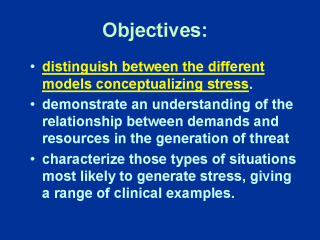| front |1 |2 |3 |4 |5 |6 |7 |8 |9 |10 |11 |12 |13 |review |
 |
There are three
things you must remember if you are to understand “stress”. 1. Models that think of stress as a “force out there” in the environment (the stress-strain models) are called “Stimulus based” (stress considered as a kind of force or stimulus). However, if stress is a “force out there” in the environment, then all people equally exposed to this force should be equally affected (just as fire will cause charring of the skin of any person). However, people clearly are variously affected in different ways be the same situations. So such simplistic models are clearly inadequate on their own to explain what people experience. 2. Models that think of stress as only the physiological response to environmental events are called “Response based” (stress as a kind of response to the environment). However, if stress is a physiological response to environmental stimuli, then each person, on repeated exposed to this force should be consistently affected each time, in a significant dose-response manner, just like skin exposed to flame is charred on each exposure. There is no learning effect for thermal damage. Again, however, the range of experiences and the variations in peoples’ reactions suggest such models of stress are themselves also inadequate. A person clearly reacts differently to different exposures to the same situations. 3. Therefore, neither stimuli nor responses alone are sufficient to explain the range of effects people report they experience. Visit the web site above to see how confusing the idea of stress has become (this page lists four “types” of stress (survival, internal, environmental and fatigue). Are these stimulus based, response based or some other kind of stress model? That web page is confused and confusing, a common problem when “stress” is mentioned, so forget what that web page said and read on. |